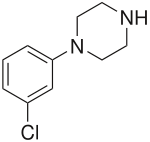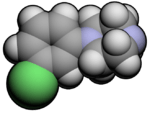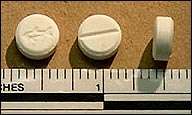meta-Chlorophenylpiperazine
 | |
 | |
| Clinical data | |
|---|---|
| Routes of administration | Oral, Nasal, Rectal |
| ATC code | none |
| Legal status | |
| Legal status |
|
| Pharmacokinetic data | |
| Metabolism | Hepatic |
| Biological half-life | 2-6 hours |
| Excretion | Renal |
| Identifiers | |
| |
| CAS Number |
6640-24-0 |
| PubChem (CID) | 1355 |
| IUPHAR/BPS | 142 |
| ChemSpider |
1314 |
| UNII |
REY0CNO998 |
| ChEBI |
CHEBI:10588 |
| ChEMBL |
CHEMBL478 |
| ECHA InfoCard | 100.026.959 |
| Chemical and physical data | |
| Formula | C10H13ClN2 |
| Molar mass | 196.676 g/mol |
| 3D model (Jmol) | Interactive image |
| |
| |
| | |

meta-Chlorophenylpiperazine (mCPP) is a psychoactive drug of the phenylpiperazine class. It was initially developed in the late-1970s and used in scientific research before being sold as a designer drug in the mid-2000s.[1][2] It has been detected in pills touted as legal alternatives to illicit stimulants in New Zealand and pills sold as "ecstasy" in Europe and the United States.[3][4]
Despite its advertisement as a recreational substance, mCPP is actually generally considered to be an unpleasant experience and is not desired by drug users.[3] It lacks any reinforcing effects,[5] produces depressive and anxiogenic effects in rodents and humans,[6][7] and can induce panic attacks in individuals susceptible to them.[8][9][10][11] It also worsens obsessive-compulsive symptoms in people with the disorder.[12][13][14]
mCPP is known to induce headaches in humans and has been used for testing potential antimigraine medications.[15][16][17] It has potent anorectic effects and has encouraged the development of selective 5-HT2C receptor agonists for the treatment of obesity as well.[18][19][20][21]
Pharmacology
mCPP possesses significant affinity for the 5-HT1A, 5-HT1B, 5-HT1D, 5-HT2A, 5-HT2B, 5-HT2C, 5-HT3, and 5-HT7 receptors, as well as the SERT.[22] It also has some affinity for α1-adrenergic, α2-adrenergic, H1, I1, and NET.[22][23] It behaves as an agonist at most or all serotonin receptors.[22][24][25] mCPP has been shown to act not only as a reuptake inhibitor of serotonin but as a releasing agent as well.[26]
mCPP's strongest actions are at the 5-HT2B and 5-HT2C receptors and its discriminative cue is mediated primarily by 5-HT2C.[22][27][28] Its negative effects such as anxiety, headaches, and appetite loss are likely mediated by its actions on the 5-HT2C receptor,[7][18][29] whereas its psychedelic effects at high doses are caused by 5-HT2A activation. However, there is also evidence for mCPP antagonism of the 5-HT2A receptor, suggesting an indirect mechanism for the drug's psychedelic effects.[30] Other effects of mCPP include nausea, hypoactivity, and penile erection, the latter two the result of increased 5-HT2C activity and the former likely via 5-HT3 stimulation.[31][32][33]
Binding affinity (Ki [nM]) towards cloned human receptors where data is available
| Protein | Ki (nM)[34] |
|---|---|
| SERT | 265.1 |
| NET | 3150 |
| 5-HT1A | 43.9 |
| 5-HT1B | 251.9 |
| 5-HT1D | 285.5 |
| 5-HT2A | 54.5 |
| 5-HT2B | 30.3 |
| 5-HT2C | 13.04 |
| 5-HT3 | 427 |
| 5-HT5A | 1354 |
| 5-HT6 | 1748 |
| 5-HT7 | 162.5 |
| α1A | 1386 |
| α1B | 914.6 |
| α2A | 145.1 |
| α2B | 105.8 |
| α2C | 123.5 |
| β1 | 2359 |
| β2 | 3474 |
| D1 | 7000 (HB) |
| D2 | >10000 (HB) |
| D3 | >10000 (RC) |
| D5 | >10000 |
| BZD receptor | >10000 (HB) |
| I1 | 758.9 (RPC12) |
| σ2 | 8350 (RPC12) |
| H1 | 326.3 |
| mAChRs | >10000 (HB) |
Legend:
RC - Cloned rat receptor
HB - Human brain receptor
RPC12 - Rat PC12 receptor
Bold text indicates non-cloned human receptor binding affinities.
Pharmacokinetics
mCPP is metabolized via the CYP2D6 isoenzyme by hydroxylation to p-hydroxy-mCPP (OH-mCPP).[35] Caution should be exercised in coprescribing inhibitors or substrates of CYP2D6 with drugs such as trazodone and nefazodone that have mCPP as a metabolite.[35]
Derivatives
Trazodone, Nefazodone, Mepiprazole, cloperidone, peraclopone,
A fluanisone analog, in which the o-Anisyl was replaced with m-chlorophenyl is described in Ex7 U.S. Patent 2,997,472 (1961).
Legal status
Belgium
mCPP is illegal in Belgium.[36]
Brazil
mCPP is illegal in Brazil.[37]
China
As of October 2015 mCPP is a controlled substance in China.[38]
Czech Republic
mCPP is legal in the Czech Republic.[39]
Denmark
mCPP is illegal in Denmark.[40]
Finland
mCPP is illegal in Finland.
Germany
mCPP is illegal in Germany.
Hungary
mCPP is illegal in Hungary since 2012.
Japan
mCPP is illegal in Japan since 2006.
Netherlands
mCPP is not illegal in the Netherlands.[41]
New Zealand
Based on the recommendation of the EACD, the New Zealand government has passed legislation which placed BZP, along with the other piperazine derivatives TFMPP, mCPP, pFPP, MeOPP and MBZP, into Class C of the New Zealand Misuse of Drugs Act 1975. A ban was intended to come into effect in New Zealand on December 18, 2007, but the law change did not go through until the following year, and the sale of BZP and the other listed piperazines became illegal in New Zealand as of 1 April 2008. An amnesty for possession and usage of these drugs remained until October 2008, at which point they became completely illegal.[42] However, it is important to note that mCPP is legally used for scientific research.
Norway
mCPP is illegal in Norway.
Russia
mCPP is illegal in Russia.
Sweden
mCPP is illegal in Sweden.
Poland
mCPP is illegal in Poland.
United States
mCPP is not scheduled at the federal level in the United States,[43] but it is possible that it could be considered a controlled substance analog of BZP, in which case purchase, sale, or possession could be prosecuted under the Federal Analog Act.
Florida
"Chlorophenylpiperazine" is a Schedule I controlled substance in the state of Florida making it illegal to buy, sell, or possess in Florida.[44]
See also
- 1-Benzylpiperazine (BZP)
- 1-Methyl-4-benzylpiperazine (MBZP)
- 1,4-Dibenzylpiperazine (DBZP)
- 3-Trifluoromethylphenylpiperazine (TFMPP)
- 3,4-Methylenedioxy-1-benzylpiperazine (MDBZP)
- 4-Bromo-2,5-dimethoxy-1-benzylpiperazine (2C-B-BZP)
- 4-Fluorophenylpiperazine (pFPP)
- 4-Methoxyphenylpiperazine (MeOPP)
- Etoperidone, Nefazodone, Trazodone - Metabolize into mCPP.
- Quipazine - A related piperazine serotonin agonist.
- Org 12,962
- 1-(3-chlorophenyl)-4-(2-phenylethyl)piperazine (3C-PEP)
References
- ↑ Bossong MG, Van Dijk JP, Niesink RJ (December 2005). "Methylone and mCPP, two new drugs of abuse?". Addiction Biology. 10 (4): 321–3. doi:10.1080/13556210500350794. PMID 16318952.
- ↑ Lecompte Y, Evrard I, Arditti J (2006). "[Metachlorophenylpiperazine (mCPP): a new designer drug]". Thérapie (in French). 61 (6): 523–30. doi:10.2515/therapie:2006093. PMID 17348609.
- 1 2 Bossong M, Brunt T, Van Dijk J, et al. (March 2009). "mCPP: an undesired addition to the ecstasy market". Journal of Psychopharmacology (Oxford, England). 24 (9): 1395–401. doi:10.1177/0269881109102541. PMID 19304863.
- ↑ Vogels N, Brunt TM, Rigter S, van Dijk P, Vervaeke H, Niesink RJ (December 2009). "Content of ecstasy in the Netherlands: 1993-2008". Addiction (Abingdon, England). 104 (12): 2057–66. doi:10.1111/j.1360-0443.2009.02707.x. PMID 19804461.
- ↑ Tancer M, Johanson CE (October 2003). "Reinforcing, subjective, and physiological effects of MDMA in humans: a comparison with d-amphetamine and mCPP". Drug and Alcohol Dependence. 72 (1): 33–44. doi:10.1016/S0376-8716(03)00172-8. PMID 14563541.
- ↑ Rajkumar R, Pandey DK, Mahesh R, Radha R (April 2009). "1-(m-Chlorophenyl)piperazine induces depressogenic-like behaviour in rodents by stimulating the neuronal 5-HT(2A) receptors: proposal of a modified rodent antidepressant assay". European Journal of Pharmacology. 608 (1-3): 32–41. doi:10.1016/j.ejphar.2009.02.041. PMID 19269287.
- 1 2 Kennett GA, Whitton P, Shah K, Curzon G (May 1989). "Anxiogenic-like effects of mCPP and TFMPP in animal models are opposed by 5-HT1C receptor antagonists". European Journal of Pharmacology. 164 (3): 445–54. doi:10.1016/0014-2999(89)90252-5. PMID 2767117.
- ↑ Klein E, Zohar J, Geraci MF, Murphy DL, Uhde TW (November 1991). "Anxiogenic effects of m-CPP in patients with panic disorder: comparison to caffeine's anxiogenic effects". Biological Psychiatry. 30 (10): 973–84. doi:10.1016/0006-3223(91)90119-7. PMID 1756202.
- ↑ Charney DS, Woods SW, Goodman WK, Heninger GR (1987). "Serotonin function in anxiety. II. Effects of the serotonin agonist MCPP in panic disorder patients and healthy subjects". Psychopharmacology. 92 (1): 14–24. doi:10.1007/bf00215473. PMID 3110824.
- ↑ Van Veen JF, Van der Wee NJ, Fiselier J, Van Vliet IM, Westenberg HG (October 2007). "Behavioural effects of rapid intravenous administration of meta-chlorophenylpiperazine (m-CPP) in patients with generalized social anxiety disorder, panic disorder and healthy controls". European Neuropsychopharmacology : the Journal of the European College of Neuropsychopharmacology. 17 (10): 637–42. doi:10.1016/j.euroneuro.2007.03.005. PMID 17481859.
- ↑ van der Wee NJ, Fiselier J, van Megen HJ, Westenberg HG (October 2004). "Behavioural effects of rapid intravenous administration of meta-chlorophenylpiperazine in patients with panic disorder and controls". European Neuropsychopharmacology : the Journal of the European College of Neuropsychopharmacology. 14 (5): 413–7. doi:10.1016/j.euroneuro.2004.01.001. PMID 15336303.
- ↑ Hollander E, DeCaria CM, Nitescu A, et al. (January 1992). "Serotonergic function in obsessive-compulsive disorder. Behavioral and neuroendocrine responses to oral m-chlorophenylpiperazine and fenfluramine in patients and healthy volunteers". Archives of General Psychiatry. 49 (1): 21–8. doi:10.1001/archpsyc.1992.01820010021003. PMID 1728249.
- ↑ Broocks A, Pigott TA, Hill JL, et al. (June 1998). "Acute intravenous administration of ondansetron and m-CPP, alone and in combination, in patients with obsessive-compulsive disorder (OCD): behavioral and biological results". Psychiatry Research. 79 (1): 11–20. doi:10.1016/S0165-1781(98)00029-8. PMID 9676822.
- ↑ Pigott TA, Zohar J, Hill JL, et al. (March 1991). "Metergoline blocks the behavioral and neuroendocrine effects of orally administered m-chlorophenylpiperazine in patients with obsessive-compulsive disorder". Biological Psychiatry. 29 (5): 418–26. doi:10.1016/0006-3223(91)90264-M. PMID 2018816.
- ↑ Leone, M; A Attanasio; D Croci; G Filippini; D D'Amico; L Grazzi; A Nespolo; G Bussone (July 12, 2000). "The serotonergic agent m-chlorophenylpiperazine induces migraine attacks: A controlled study". Neurology. 55 (1): 136–139. doi:10.1212/wnl.55.1.136. PMID 10891925.
- ↑ Martin RS & Martin GR. Investigations into migraine pathogenesis: time course for effects of m-CPP, BW723C86 or glyceryl trinitrate on appearance of Fos-like immunoreactivity in rat trigeminal nucleus caudalis (TNC). Cephalalgia 2001; 21:46–52. London. ISSN 0333-1024
- ↑ Petkov VD, Belcheva S, Konstantinova E. Anxiolytic effects of dotarizine, a possible antimigraine drug. Methods Find Exp Clin Pharmacol. 1995 Dec;17(10):659-68.
- 1 2 Kennett GA, Curzon G (1988). "Evidence that hypophagia induced by mCPP and TFMPP requires 5-HT1C and 5-HT1B receptors; hypophagia induced by RU 24969 only requires 5-HT1B receptors". Psychopharmacology. 96 (1): 93–100. doi:10.1007/BF02431539. PMID 2906446.
- ↑ Sargent PA, Sharpley AL, Williams C, Goodall EM, Cowen PJ (October 1997). "5-HT2C receptor activation decreases appetite and body weight in obese subjects". Psychopharmacology. 133 (3): 309–12. doi:10.1007/s002130050407. PMID 9361339.
- ↑ Hayashi A, Suzuki M, Sasamata M, Miyata K (March 2005). "Agonist diversity in 5-HT(2C) receptor-mediated weight control in rats". Psychopharmacology. 178 (2-3): 241–9. doi:10.1007/s00213-004-2019-z. PMID 15719229.
- ↑ Halford JC, Harrold JA, Boyland EJ, Lawton CL, Blundell JE (2007). "Serotonergic drugs : effects on appetite expression and use for the treatment of obesity". Drugs. 67 (1): 27–55. doi:10.2165/00003495-200767010-00004. PMID 17209663.
- 1 2 3 4 "PDSP Database - UNC".
- ↑ Silverstone PH, Rue JE, Franklin M, et al. (September 1994). "The effects of administration of mCPP on psychological, cognitive, cardiovascular, hormonal and MHPG measurements in human volunteers". International Clinical Psychopharmacology. 9 (3): 173–8. doi:10.1097/00004850-199409000-00005. PMID 7814826.
- ↑ Samanin R, Mennini T, Ferraris A, Bendotti C, Borsini F, Garattini S (August 1979). "Chlorophenylpiperazine: a central serotonin agonist causing powerful anorexia in rats". Naunyn-Schmiedeberg's Archives of Pharmacology. 308 (2): 159–63. doi:10.1007/BF00499059. PMID 503247.
- ↑ Odagaki Y, Toyoshima R, Yamauchi T (May 2005). "Trazodone and its active metabolite m-chlorophenylpiperazine as partial agonists at 5-HT1A receptors assessed by [35S]GTPgammaS binding". Journal of Psychopharmacology (Oxford, England). 19 (3): 235–41. doi:10.1177/0269881105051526. PMID 15888508.
- ↑ Pettibone DJ, Williams M (May 1984). "Serotonin-releasing effects of substituted piperazines in vitro". Biochemical Pharmacology. 33 (9): 1531–5. doi:10.1016/0006-2952(84)90424-6. PMID 6610423.
- ↑ Callahan PM, Cunningham KA (May 1994). "Involvement of 5-HT2C receptors in mediating the discriminative stimulus properties of m-chlorophenylpiperazine (mCPP)". European Journal of Pharmacology. 257 (1-2): 27–38. doi:10.1016/0014-2999(94)90690-4. PMID 8082704.
- ↑ Gommans J, Hijzen TH, Maes RA, Olivier B (June 1998). "Discriminative stimulus properties of mCPP: evidence for a 5-HT2C receptor mode of action". Psychopharmacology. 137 (3): 292–302. doi:10.1007/s002130050622. PMID 9683007.
- ↑ Kennett GA, Curzon G (May 1988). "Evidence that mCPP may have behavioural effects mediated by central 5-HT1C receptors". British Journal of Pharmacology. 94 (1): 137–47. doi:10.1111/j.1476-5381.1988.tb11508.x. PMC 1853919
 . PMID 3401632.
. PMID 3401632. - ↑ Fiorella, D.; Rabin, R. A.; Winter, J. C. (1995-05-01). "The role of the 5-HT2A and 5-HT2C receptors in the stimulus effects of m-chlorophenylpiperazine". Psychopharmacology. 119 (2): 222–230. ISSN 0033-3158. PMID 7659770.
- ↑ Kłodzińska A, Jaros T, Chojnacka-Wójcik E, Maj J (1989). "Exploratory hypoactivity induced by m-trifluoromethylphenylpiperazine (TFMPP) and m-chlorophenylpiperazine (m-CPP)". Journal of Neural Transmission. Parkinson's Disease and Dementia Section. 1 (3): 207–18. doi:10.1007/BF02248670. PMID 2775468.
- ↑ Walsh AE, Smith KA, Oldman AD, Williams C, Goodall EM, Cowen PJ (September 1994). "m-Chlorophenylpiperazine decreases food intake in a test meal". Psychopharmacology. 116 (1): 120–2. doi:10.1007/BF02244883. PMID 7862925.
- ↑ Stancampiano R, Melis MR, Argiolas A (August 1994). "Penile erection and yawning induced by 5-HT1C receptor agonists in male rats: relationship with dopaminergic and oxytocinergic transmission". European Journal of Pharmacology. 261 (1-2): 149–55. doi:10.1016/0014-2999(94)90313-1. PMID 8001637.
- ↑ Roth, BL; Driscol, J (2011-01-12). "PDSP Ki Database". Psychoactive Drug Screening Program (PDSP). University of North Carolina at Chapel Hill and the United States National Institute of Mental Health. Retrieved 2013-10-18.
- 1 2 Rotzinger S, Fang J, Coutts RT, Baker GB (December 1998). "Human CYP2D6 and metabolism of m-chlorophenylpiperazine". Biological Psychiatry. 44 (11): 1185–91. doi:10.1016/S0006-3223(97)00483-6. PMID 9836023.
- ↑ EMCDDA
- ↑ ANVISA resolution - Portaria SVS/MS 344/98
- ↑ "关于印发《非药用类麻醉药品和精神药品列管办法》的通知" (in Chinese). China Food and Drug Administration. 27 September 2015. Retrieved 1 October 2015.
- ↑
- ↑ Erowid.org
- ↑ http://wetten.nl/BWBR0001941/geldigheidsdatum_05-08-2015
- ↑ Misuse of Drugs (Classification of BZP) Amendment Bill 2008
- ↑ 21 CFR — SCHEDULES OF CONTROLLED SUBSTANCES §1308.11 Schedule I.
- ↑ Florida Statutes - Chapter 893 - DRUG ABUSE PREVENTION AND CONTROL